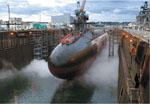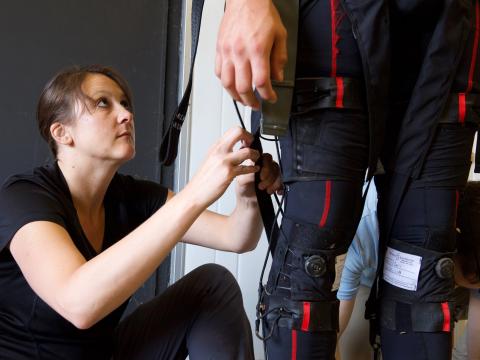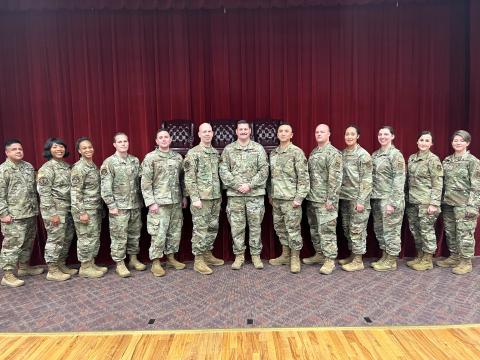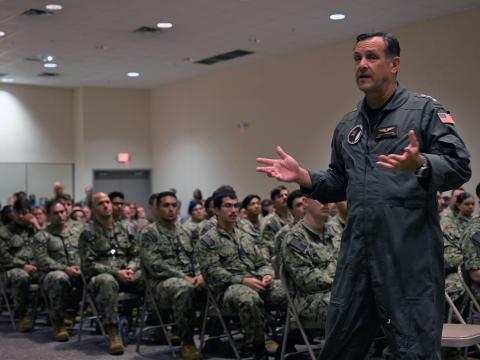Lasers Target Covert Communications
Proposed experiment explores connectivity between submarines and special operations forces. 
SOFs climb aboard a small submersible that affords covert transportation from a submarine to a landing zone.
Conversion of four of the U.S. Navy’s Trident missile submarines into covert transportation for
As early as the Apollo space program, scientists were exploring the uses for laser beams, and NASA projected them all the way to the moon. While the beam was not carrying data, voice or video, the work did demonstrate that laser beams could travel vast distances. However, there also is a vast difference between sending a beam through space and using it to communicate on the ground, particularly near an ocean’s surface. While the properties of space make it conducive to line of sight without interference, the unpredictable and sometimes volatile nature of Earth’s atmosphere poses challenges that must be overcome—or a least compensated for—if lasers are to be used successfully as a communications medium.
As with a lot of barrier-breaking research, the latest attempt to explore this means of information transmission began with change in an unrelated area. In 2000, the Navy began transforming four of its 18 Trident missile submarines. Rather than carrying nuclear-tipped missiles, the 24 large missile tubes in each were converted to carry cruise missiles and to house armaments and equipment for special operations forces (SOFs). In the modification, the submarine-launched ballistic missile capability was replaced, giving the four submarines the ability to launch as many as 154 precision-guided conventional weapons. In addition, they can accommodate up to 66 SOF personnel as well as two advanced SEAL delivery systems or two dry deck shelters. Modular masts offer the option to change payloads in a matter of hours.
During the past eight years, the USS Ohio, USS Michigan, USS Florida and USS Georgia all have returned to service with navigation centers that were renovated into battle management centers. From inside these centers, commanders direct highly covert special operations teams as they travel through enemy waters to infiltrate coastlines.
Dr. William Weiss, principal investigator at the Naval Undersea Warfare Center (NUWC),
To provide this capability, NUWC has proposed an experimental program that would assess the effect of real-world weather conditions on laser communications between submarines and SOF teams on land. The yearlong experiment would take place on Narragansett Bay in
Two-way communication using lasers is fraught with challenges other than weather. It requires line of sight, which can be an obstacle when submarine periscopes or masts are situated near the waterline during covert operations, not more than 10 feet above it, Weiss estimates. In addition, this proximity to the water means that even in calm seas, water droplets and haze also could hinder transmissions. And, at a maximum height of 10 feet, the horizon is very near, limiting the distance between sender and receiver. Weiss estimates that taking all of these elements into consideration, the reasonable distance between sender and receiver for communication would be 10 or 12 miles.
Even though the capability would enable submarine crews to communicate with SOFs situated only 10 to 12 miles away, it would still be an asset. The limitations “might make it sound like it’s not useful, but if you think about all the places where submarines might be going these days, those distances actually could be very useful,” he says.
But conditions on top of the submarines are only half of the communicating equation; the other half is on land where the receiver, called a target, can be as small as a quarter. Even when a very narrow laser beam is spread out a bit, hitting the target—which comprises a lens and several detectors—several miles away can be difficult.
Using more than one detector allows message senders to realign the lasers when motion is detected, adjustments that are made very quickly—at millisecond or even microsecond rates, Weiss explains. “With satellites and buildings, it’s doable—it’s very expensive, but it’s doable. We don’t know how well this is going to work with these kinds of vehicles that are in constant, unpredictable motion,” he states. “It’s not an unsolvable problem, but I’m not convinced it’s easy to solve.”
Despite the challenges, Weiss believes the benefits of laser communications bear out its potential usefulness in the field, and he puts increased bandwidth at the top of his list. For example, if a special operations team on shore needs maps or photographs, or if they have visual intelligence to send to the ship, these bidirectional communications could take place on the order of tens or even hundreds of megabytes per second, he explains.
 |
| The USS Ohio was the first of four Trident submarines the U.S. Navy converted from a ship, submersible, ballistic, nuclear (SSBN) to a ship, submersible, guided, nuclear (SSGN) submarine. The modifications include advanced sensors and surveillance systems, rapid precision strike capabilities, assured access to hostile or denied areas and a high tooth-to-tail ratio, which refers to the ratio of combat power to required support. |
Another advantage that tops Weiss’ benefit list is the secure and covert nature of the communications. “If somebody doesn’t know where to look or what kind of detector to use, he’s just not even going to know communication is taking place. All of this would be digital, and it would all be encrypted. So, even at the outside, if someone knows where to look and sees it, he won’t figure out what it is. Of course that’s pretty dangerous anyway. He would have to be right in the line of sight to intercept it,” Weiss offers.
As envisioned, the laser mounted on the submarine would most likely be the payload on the modular mast or integrated into a periscope, similar to the way laser rangefinders already are being incorporated into the Virginia-class submarines. “It may be that something very similar could be done for laser communications. I’m not sure the package needs to be any larger or use any more power than we’re already using. The receiving part we would have to work on, but I don’t think that has to be large or complicated either,” Weiss explains.
The project also would be able to piggyback on work underway at the Naval Research Laboratory (NRL). Scientists there have conducted experiments using laser communications equipment mounted on surface ships approximately 100 feet above the craft. Despite environmental differences, Weiss is confident the work on submarines could benefit from the NRL’s efforts. “The atmosphere actually can be pretty different between that height and our height, but in terms of experimental design, equipment and overall knowledge, there’s no reason for us to duplicate it. We would just lower the height and work much closer to the water, which can be substantially different,” he relates.
Safety requirements are another difference between installing the equipment on a surface ship and submarine. Weiss explains that mounting the equipment will be part art and part science as openings could leave the submarine vulnerable to water seepage.
However, while permanently installing laser communications transmitters and receivers on submarines could take many years, Weiss reveals another possibility: temporary alteration, which is extremely different than programs of record. The approach would enable the Navy to integrate the devices into an existing submarine for the purpose of experimentation or even an actual mission.
“The temporary alteration is not nearly as complicated and difficult, and that could be done in a reasonable amount of time based on priorities—six months, a year. If there’s an actual, real mission, it could probably be done faster than that. Of course, we would have to have the equipment to do it. We would take what we have in the lab, package it for subs, and go out and put it on a sub temporarily,” he explains.
But even on an accelerated schedule, special operations forces are not likely to be using laser communications with submarines in the very near future. Once the project studying the effect of weather on laser communications is approved, Weiss and his team of three or four scientists will need to purchase and set up the laser communications equipment on
Data collection would occur at least twice daily for a year to enable the scientists to observe all possible sun and moon angles as well as temperature and weather effects on laser communications. “Other work can be taking place in parallel. We don’t have to wait until the end of the year to analyze the data; we can do that as it comes in and be working on other parts of the experiment,” Weiss adds. One possible manpower source to assist in the effort is a Navy Reserve unit stationed in
Many of the technical aspects of laser communications are supported by work already underway in the fiber optic communications arena, Weiss says. He believes some work is taking place on advances in smaller, less expensive, longer wavelengths, which would be particularly useful to the submarine community. “When we get into longer wavelengths, they penetrate some particles in the air—water vapor, for example—a little bit better. How far is the work that is taking place getting? I don’t know,” he relates.
The status of the effect of weather on laser communications proposal remains uncertain. However, Weiss maintains that some organizations have expressed interest in it.
Web Resource



